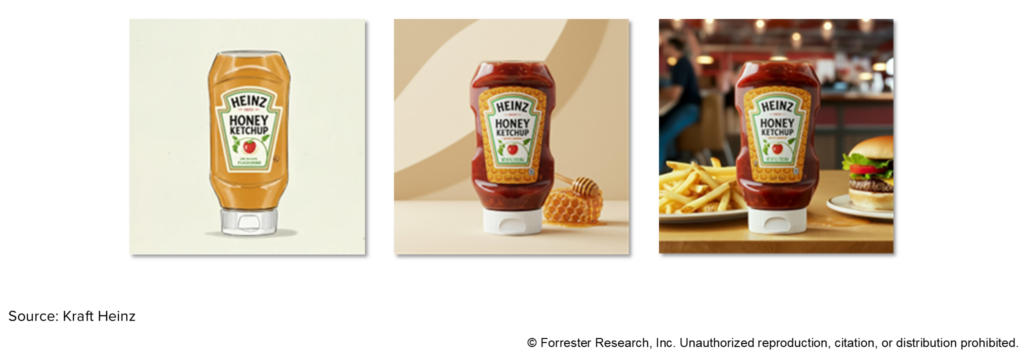How Kraft Heinz Is Using GenAI To Reimagine The Future Of Creative Content
If you haven’t seen it yet and have 55 seconds to spare, I highly recommend you take a look at Heinz’s “A.I. Ketchup” campaign. By asking Dall-E 2 to generate an image of a ketchup bottle, the firm provided creative and entertaining proof that Heinz is not just another ketchup brand. Ketchup is indeed synonymous with the Heinz brand.
But Kraft Heinz didn’t stop at marketing campaigns when it comes to using generative AI (genAI) for design and innovation. In a bold move to modernize its internal design processes, Kraft Heinz embraced genAI to scale content creation and personalization. The result? A complete reimagining of how one of the world’s largest food and beverage companies brings its iconic brands to life.
From Bottlenecks To Breakthroughs: The Creative Challenge
With over 100 brands and a global footprint, Kraft Heinz faced a familiar but formidable challenge: how to keep packaging and marketing content fresh, personalized, and on brand message — without the long lead times and high costs of traditional agency workflows.
Justin Thomas, Kraft Heinz’s head of digital experience and growth, described the problem as follows: “How can we leverage AI to create more engaging personalized content at scale, reduce costs and time-to-market for product concepts, and do so while maintaining brand consistency and data security?”
Enter the TasteMaker, the company’s custom-built retrieval-augmented generation (RAG) engine. Developed in partnership with Apply Digital and powered by Google’s Vertex AI, TasteMaker is more than a tool — it’s an innovation and design engine.
Examples Of Kraft Heinz Product Content Produced By The TasteMaker RAG Engine

What Makes TasteMaker A Game Changer?
- Speed-to-market: Kraft Heinz slashed design timelines for its product content from weeks to hours, reducing time by 8x.
- Personalization at scale: Whether creating new assets or versioning image, motion, and video creative, TasteMaker enables the generation of content on demand.
- Brand consistency and data security: By codifying internal brand assets and using a proprietary AI instance, Kraft Heinz ensures that the results are on brand and that its IP remains secured.
The Playbook: Experiment, Pilot, Expand
Kraft Heinz didn’t wait for perfection. The team launched fast, starting with four use cases and scaling quickly after early wins, focusing on:
- Solving real business problems, not just showcasing tech.
- Getting data AI-ready, from brand IP to consumer insights.
- Empowering teams, with training, prompt engineering, and hands-on support.
What’s Next?
In parallel to deploying the solution across product lines, Justin Thomas and the TasteMaker team have established an ambitious roadmap:
- Continuous improvement through refining image generation and integrating more proprietary data
- Adding further capabilities and use cases, such as video generation
- Moving further down the innovation funnel by adding synthetic users and user testing features
While the current results and the roadmap are impressive, the real story is the mindset shift. TasteMaker isn’t just a tool; it’s a new way of working and driving creative design.
Do you want to dive deeper into the details of how a 150-year-old brand is leading the AI-powered future of creativity? Read the full case study to explore how Kraft Heinz is turning generative AI into a competitive advantage.
